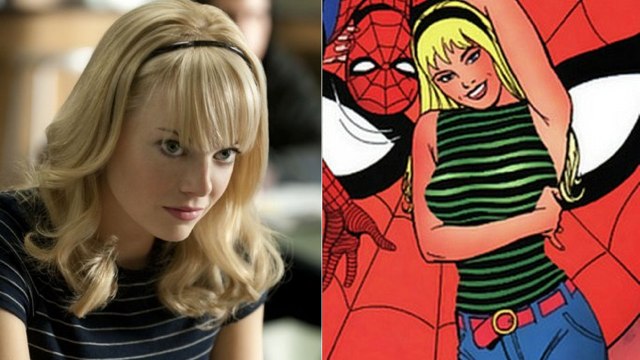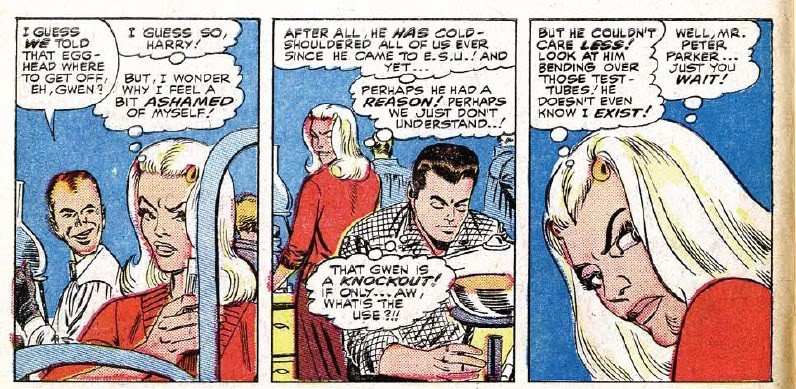One of the more remarkable and unexpected aspects of the new Amazing Spider-Man film is how much time and energy the movie puts into developing not just Peter Parker (Andrew Garfield), but also his love interest, Gwen Stacy (Emma Stone). In fact, I’d hesitate to characterize her as simply a love interest – over the course of the film, she is at turns his confidant, mentor, and crimefighting partner, as well as his girlfriend. This is refreshing in the general context of how romantic interests are treated in many superhero movies (for example, in the 2002 Spider-Man trilogy, romantic interest Mary Jane Watson remains something of a fickle cipher, despite ample screen-time), but it’s also surprising to me, as a viewer, having expected the familiar headband-and-go-go-booted blonde. After having my assumptions turned on their head by Stone’s performance, I set out contrast the original comics character with her film incarnation.
At first blush, it seems like a radical departure from her portrayal in the main-line Marvel Universe, as a kind but ultimately naive and shallow 1960’s hipster, whose true impact on her world is less about what she does, and more about what’s done to her. As I dug deeper into the character, I was surprised to find that the seeds of the new big-screen Gwen were already there, spread out over decades of issues, across multiple timelines, and often buried beneath layers of ham-fisted melodrama.
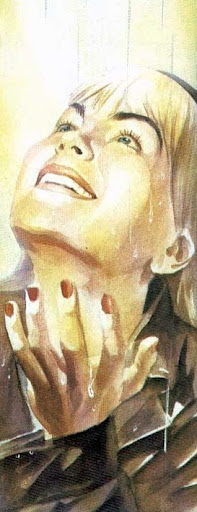
Gwen Stacy, entranced by the strange beauty of an Atlantean invasion in “Marvels” #5. Art: Alex Ross.
Ask a long-time Spider-Fan to describe Gwen Stacy, and what you’re likely to hear is that she’s Peter’s first love, the quintessential girl-next-door, and ultimately a victim of the hazards of the superhero life. In the decades since, writers have had Spidey dwell on her memory to a point where she became something of a saintly figure to both Peter Parker and the fanbase. The beatification of Gwen Stacy reached its apex in Kurt Busiek and Alex Ross’ seminal 1994 miniseries Marvels, where Gwen was cast as the wide-eyed, childlike representative of the innocents that superheros fight to protect, and her death represents a crisis of faith for those who believe in them (and, by extension, creators and fans). To many comics historians, her death in 1973’s Amazing Spider-Man #121 marked the end of the idealistic, explosively-creative Silver Age of Comics.
The problem with this perception of Gwen – an innocent, the girl next door, the pretty-if-slightly-dull romantic interest, the patron saint of Women in Refrigerators – is that it’s not strictly accurate. There’s a bit more to her Marvel Universe incarnation (even if we ignore the clones and ill-advised retconning, resulting in her bearing Norman Osborn’s twins). Her wit, her interest in science, her connection with Peter in the film: they didn’t come from nowhere.
When she’s first introduced in Amazing Spider-Man #31, it’s established that, yes, Gwen Stacy is a high school beauty queen, but she’s otherwise a far cry from the Gwen we thought we knew. Rather than soft features, an easy smile, and the iconic headband and boots, Ditko’s pencils give us a nascent femme fatale. If anything, her predilection for the color red and horn-like hair accessories, as well as her angular features and arched eyebrows, imply someone who’s more devil than angel. From the very first, with her sharp tongue and her encyclopedic knowledge of who’s who, it’s clear Gwen knows the score.
These first appearances also begin to establish Gwen’s status as Peter’s intellectual peer, although the evidence sadly remains mostly circumstantial. While this early Gwen might play the part of the vixen, it’s interesting to note that her interactions with Peter and Harry Osborn (son of arch-villian Norman Osborn, the first Green Goblin) happen not only on the Empire State University quad, but also in the lecture halls, laboratories, and technology demonstrations. Regardless of how she presents herself, Gwen has essentially the same freshman class schedule as both the science scholarship recipient from Queens and the highly-motivated, private-school-educated scion of a chemical and technology empire. In fact, the widely-reviled Clone Saga of the 1990’s Spider-Man comics was set into motion by geneticist Miles Warren, one of Gwen’s professors at ESU. Taken together with the declaration, about twenty issues later, that she was in fact a majoring in biochemistry, one could make the case that Gwen is a heck of a lot smarter than she’s given credit for.
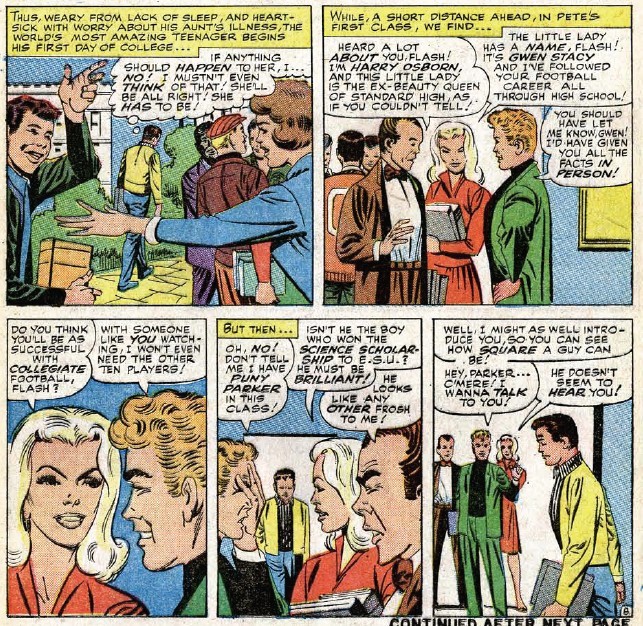
Gwen & Harry’s first appearance, Spider-Man #31. Not that Peter notices. Art: Steve Ditko. Words: Stan Lee.
In a reversal of what we’d expect – the nerd pining after the pretty girl – Gwen was actually attracted to Peter precisely because of his reputation as something of a genius, in stark contrast to the oafish Flash Thompson and preppy rich boy Harry Osborn. In fact, she finds his apparent aloofness initially alluring. As a girl used to being fawned over by men, she (in the mind of writer Stan Lee) relishes the challenge that bookish Peter presents. But it soon becomes apparent that Peter is too wrapped up in his studies and Aunt May’s health woes to give even her the time of day. Eventually, Gwen has enough of being snubbed and the claws come out.
From then on, she joins Flash and Harry as one of Peter’s tormentors – playing pranks, ragging on him about how “stuck up” he is, and generally trying to take him down a peg. Still, she can’t quite shake her attraction to him, but every chance meeting becomes another sparring match.
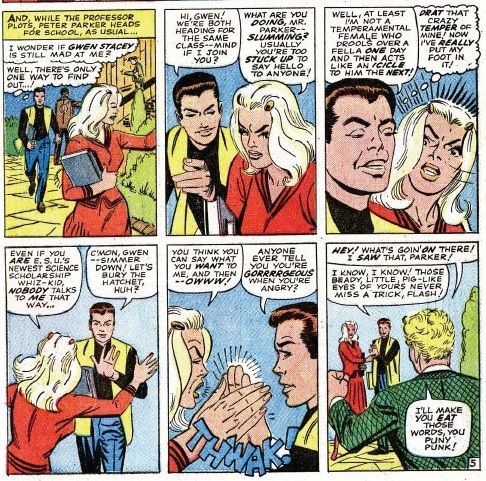
On the other hand, maybe she’s entirely justified in being pissed off. Pete’s a creep. Art: Steve Ditko. Words: Stan Lee.
Despite Peter’s chronic case of foot-in-mouth (which is mirrored in a far less chauvinistic way by Garfield’s adorable stammering), Gwen just can’t quite cut the seemingly anti-social whiz kid out of her life, establishing a pattern where Pete and Gwen attempt to reach out to each other, Peter’s other responsibilities get in the way, and Gwen cuts him down with a snappy rejoinder.
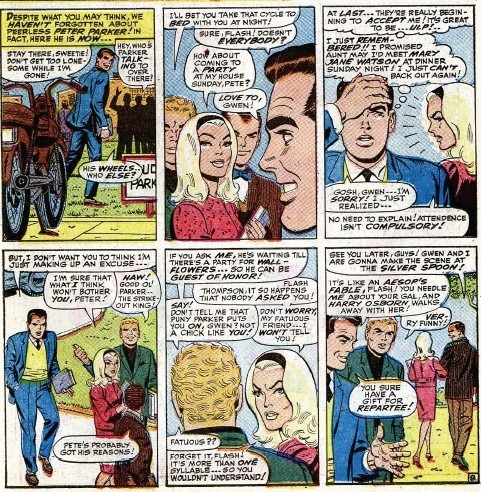
Like that one time, when Pete bought a motorbike, but then couldn’t make it to Gwen’s sock hop. True story. Art: John Romita, Sr. Words: Stan Lee.
In fact, at the time it seemed like The Amazing Spider-Man had something of a split personality as a series. On the one hand, it was a rollicking superhero adventure. On the other hand, half the time it behaved quite a bit like the romance comics the late 1950’s. Key to this dynamic was new penciller, John Romita Sr., who cut his teeth on DC’s romance line from the mid-50’s until 1965 and was brought in to replace Spider-Man co-creator Steve Ditko. With Romita’s run came a series of subtle redesigns and personality shifts to Spidey and his supporting cast, which saw Peter become fast friends with this former antagonists Harry and Flash, and began Gwen’s transformation into the softer, more vulnerable character familiar to us.
The semi-antagonistic non-relationship between Peter and Gwen (and ASM‘s resemblance to a romance strip) got a kick in the pants shortly after Romita came on, in issue #42, when Aunt May and her neighbor Anna conspire to set Peter up on a blind date with, well… you know…
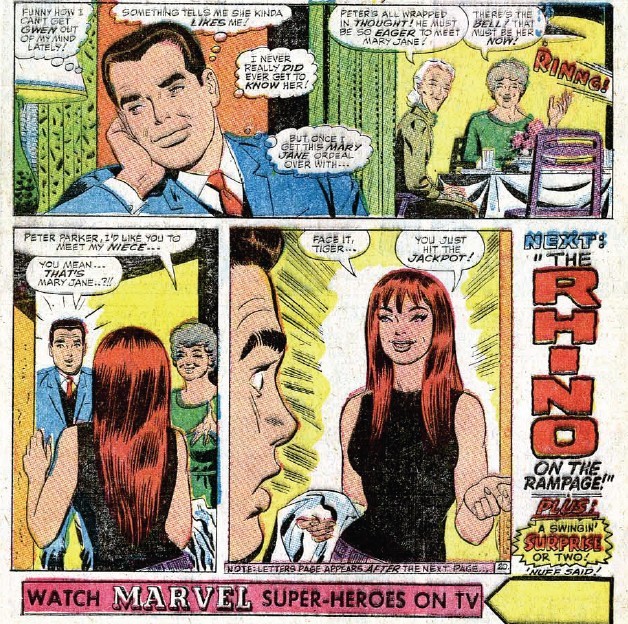
The one line every version of Mary Jane is contractually obligated to recite. Art: John Romita, Sr. Words: Stan Lee.
In the next post, I’ll look at how the Betty & Veronica dynamic between Gwen and Mary Jane eventually lead Peter and Gwen to own up to their feelings, and, in case we forget this is a superhero post, how Spider-Man starts them on the road to tragedy.

